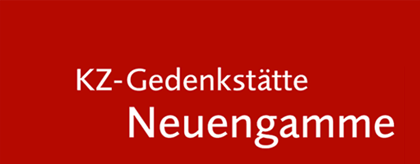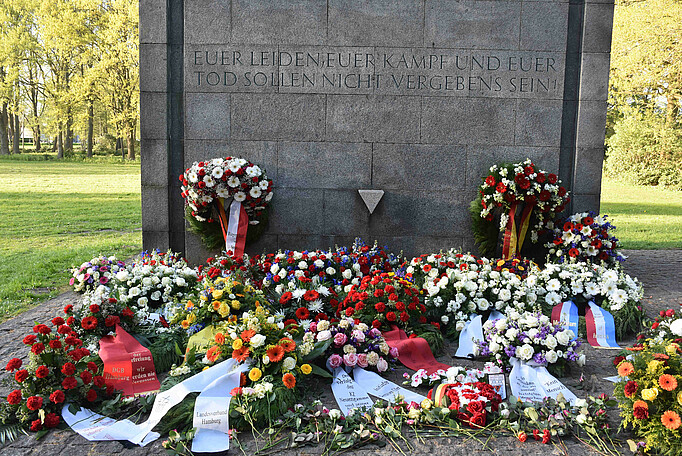10/17/2023 Conference, Report
"Shifts of Time": Report from the Colloquium on the Revision of the International Memorial at the Neuengamme Concentration Camp Memorial.
The "International Memorial" at the Neuengamme Concentration Camp Memorial is a protected monument that was erected in 1965 by the city of Hamburg through an initiative of the Amicale Internationale de Neuengamme (AIN). Part of the historic site are 22 memorial stones naming the countries of origin of the Neuengamme Concentration Camp prisoners. In the planned redesign of the memorial, one of the main goals is to take into consideration the changes of nation states overtime and to make victim groups who do not see themselves represented in the current site visible in an appropriate way.
The open online colloquium on the redesign of the memorial was attended by representatives of the expert commission of the Hamburg Memorials and Learning Places Foundation (SHGL), which also initiated the public discussion, as well as employees of the Neuengamme Concentration Camp Memorial and other memorials, representatives of the AIN, and those from other associations and scientific and civil society contexts. The participants critically examined the functionality of the memorial, expectations for the planned redesign, and design ideas.
Functions of the memorial
Oliver von Wrochem (SHGL) and Alexandra Köhring (SGHL) began by outlining the functions of the memorial site. The International Memorial is integrated into a larger memorial area with several memorial sites, including the park “Gedenkhain" (memorial grove) ,which was established in 1970, the House of Remembrance (1995), and the “Space to Remember” (2021). Different types of commemoration take place at these sites, ranging from collective practices at official commemorations, to group commemoration by survivors and relatives, to anonymous individual commemoration....
Cultures of Memory and Decolonization in Eastern and Southeastern Europe
In the first part of the colloquium, historians from Ukraine, Belarus, Slovenia, and Russia presented on the culture of memory and monuments with a focus on Eastern and Southeastern Europe. They reported on the processes of nationalization and decolonization within the historical contexts and memorial landscapes of the region.
Ihor Dvorkin (National Technical University of Kharkiv) presented on the dismantling of the Soviet narrative of the "Great Patriotic War" in Ukraine from 1991 to the present, as well as the development towards a critical and differentiated understanding of the events of World War II. The war in Ukraine in 2022 and 2023, however, has drastically change public memory and made a common commemoration of a victory of the USSR impossible at present and for the foreseeable future.
Svitlana Telukha (Kharkiv National Technical University / GWZO Leipzig) reported on her work with oral history archives, observing both overlaps in memories of World War II and the present war. She noted these changes manifest themselves in university teaching: students carry the situation of the current war with them, which adds perspective to historical discussions.
Gal Kirn (University of Ljubljana) looked back on the Yugoslavian culture of remembrance, in which the partisan movement of resistance against fascism has historically been at the center. After the destruction of memorials during the civil war and reconstruction, an uncritical treatment of local fascism and collaboration has often set in. In the national(istic) narrative of reconciliation as a path to the future, political and historical conflicts tend to be level. This has fostered the establishment of historical, ethnic, cultural, and religious categories in victim commemoration.
Iryna Kashtalian (University of Bremen, formerly of the Geschichtswerkstatt Minsk) described the political instrumentalization of the events of the Second World War in Belarus after 2020, which was massively influenced by Russia and the Orthodox Church, the consequences being the concealment of "uncomfortable stories," a marginalization of the Holocaust, and the strong hierarchization of the victims under the narrative of a genocide of the Belarusian people.
Ekaterina Makhotina (University of Göttingen) summarized the practices of decommunization at Soviet memorials in the successor states of the Soviet Union, focusing primarily on Lithuania and Ukraine. With Russia's war against Ukraine, she said, further processes of reinterpretation, dismantling, and nationalization are underway, as well as with reference to 1941-1945 and 2014-2023. She described the current trend in memory cultures as a "victim turn," leading to a kind of individual appropriation of commemorative practices, such as with reenactments.
The reports vividly showed the historical and political functionalization of the Second World War and National Socialism as "ideological wars" in the current political situation ("heat of ideological war in the current political situation"), which conditioned extreme divergences in the categorization of victims. The massive impact of the current war on civil society also becomes an integral factor of memory culture.
Perspectives for a revision: historicity / materiality / formal language and digital remembering / ecommemoration (digital commemoration) / hybrid forms
Stefanie Endlich (freelance researcher, Berlin) described how large concentration camp memorials have dealt with the topic of nation states in their memorial areas in the past and present. Typical, she said, was the emergence of multi-part ensembles, many of which are constantly being expanded. At the same time, the memorials continued to search for concepts that could promote communal remembrance.
Iris Groschek (SHGL) explained the possible use of digital applications as part of the expansion of memorial sites - as a supplement, replacement, stand-alone, as well as interactive format. A variety of audiovisual and technical-media options (BYOD, app, beacons, loanable devices, digital panels, AR/VR/XR, and others) are now available for this purpose. Informative formats and storytelling formats could be designed with changeable content (by both the memorial and users). The fundamental question is how to address the format.
The workshop discussions as well as the final discussion of Habbo Knoch and Kirsten Heinsohn, representatives of the commission of the SHGL, Martine Letterie, the president of the AIN, Cornelia Siebeck and Oliver von Wrochem, and representatives of the SHGL showed a need for change and feedback. These discussions resulted in several main ideas as well as questions and approaches for the redesign:
- Today’s situation is fundamentally different than that of the 1960s, when commemoration and state (national) consciousness policies were closely related to each other, at least on an official level. Today's situation is characterized by a disconnect between victim memory and victim identification. Feelings of belonging, personal narratives, established practices of national commemoration, and critiques of the idea of monolithic communities form strong areas of friction.
- Unacceptable is the continuation of Russia's claim of hegemony and the homogenization of the multiethnic Soviet Union, as well as other practices that minimize foreign attributions (keyword: "white authorship").
- The consensus was the desire to represent the diversity of the groups of inmates, the resistance and the anti-fascist struggle (keyword of "agency"), as well as the internationality, diversity, heterogeneity, and individuality of the concentration camp prisoners.
- What is necessary is the historicization of the 1965 facility with appropriate information and orientation on site, for example, with an information board, with reference to other memorial sites at the memorial.
- The commemorative character of the site should be preserved (keyword "mission to remember and remind," without a narrative of reconciliation).
- The advantages of a curatable digital module were emphasized. The weighting of the functions, information, participation/interaction, and criticism of the national collective memory remained open to discussion.
- The desire for a modern design with an artistic approach that does not overwhelm the facility and does not overtax visitors, that is "surprising" and innovative with new media, and that "brings the stones to life" (for example, by means of animation, graphics) was emphasized.
- Concrete design suggestions were mentioned:
- Ensemble for all known nationalities (variety of nations as a special historical feature of the Neuengamme Concentration Camp),
- Creation of a board along the path for individual commemorative signs and decoration of the sides of the concentration camp memorial,
- Creation of individual biographies/portraits as (digital) memorial plaques.
- Another suggestion was to leave the site to commemorate collectively at another location, demonstrating new ways of inclusive commemoration.
The results of the discussion will be incorporated into a concrete proposal for the redesign, which SHGL is developing in coordination with the AIN with historic preservation and in bilateral exchange with interest groups.
In conclusion, two statements can be considered with the end of the colloquium:
"As long as the international memorial is used for commemoration, it must be supplemented"
"The longer the war lasts, the more the culture of remembrance will be burdened"
Flyer World War II memory politics in Ukraine
Report: Alexandra Köhring, Translation: Casey Sennett




